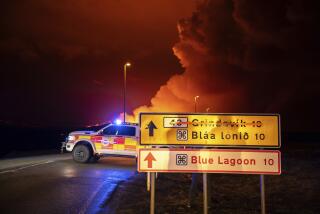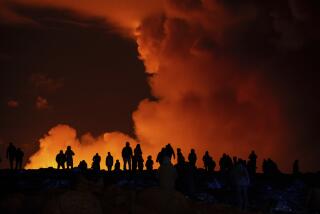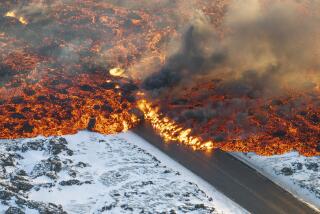Scientists follow magma from Earth’s belly to base of Mt. Rainier
The lava that spews from the fiery rims of volcanoes originates deep in Earth’s crust, often more than 50 miles below our feet. Although scientists have a general idea where this magma comes from, it’s nearly impossible to see exactly what’s happening so far beneath the surface.
Recently, however, scientists used a network of extremely sensitive instruments that act like metal detectors to shed light on this process. In a study published Wednesday in the journal Nature, researchers painted a superbly detailed picture of the plumbing beneath Washington’s Mt. Rainier, an active volcano.
The scientists found that most of the volcano’s magma forms deep in the mantle, where water trapped in old oceanic crust escapes and melts the rocks around it. The magma then rises more or less straight up in a massive column toward the surface, pooling in a reservoir beneath the 14,000-foot peak.
One of the questions the researchers set out to answer was “whether the melt goes up through a network of cracks, or whether it gets dragged up in little bits, or rises in diapirs,” said R. Shane McGary of the Woods Hole Oceanographic Institute, lead author of the study.
Diapirs are “just like what you would see in a lava lamp: a blob that gets heated up and rises,” McGary said. The new study suggests Mt. Rainier sits atop an impressive chimney of melt, but preliminary evidence from nearby Oregon volcanoes shows that they do not. Scientists say this reveals how even neighboring volcanoes can have different dynamics.
“I would regard Mt. Rainier as a much more serious short-term threat than Mt. Jefferson in Oregon, which lacks a flow path,” McGary said, although he notes that no eruptions are imminent.
“A study like this isn’t going to tell us when Mt. Rainier will erupt the next time,” said Martyn Unsworth, a geophysicist at the University of Alberta in Canada. “What it does is give a bigger picture: why volcanoes are where they are.”
Though scientists might debate the finer points of the new study — one outside expert said the authors had mistaken a coal deposit for a shallow magma reservoir — they agree that the results present a road map for how magma moves from deep in the mantle all the way to the bowels of Mt. Rainier.
If you think back to middle school science class, you might be able to conjure up a textbook image of the rock cycle: old crust gets gobbled up at plate boundaries and then reborn as lava. This happens all around the Pacific “Ring of Fire,” including along the West Coast from Northern California up to Alaska. These volcanoes form at the surface, above where oceanic crust slips beneath the continent in a process known as subduction.
Diving at about a 45-degree angle from where it ducks under the North American plate, doomed oceanic crust sinks deep into Earth’s mantle and is eventually cannibalized by the extreme temperatures and pressures it encounters. This process creates melt that percolates upward — that’s why volcanoes typically sit a few hundred miles inland from the plate boundary, which lies offshore under the chilly waters of the North Pacific.
Though there is no question that subduction creates magma, there are many ways it could happen. One is that the sinking oceanic slab pulls some solid mantle material down with it, creating a kind of vertical whirlpool. The rising limb of the whirlpool brings rocks from greater pressures at depth to lower pressures closer to the surface, causing the rock to melt.
Another important mechanism involves water trapped inside oceanic crust that escapes into the surrounding mantle and changes the melting temperature of the rocks around it, the way adding salt to pasta water changes the boiling point.
McGary and his colleagues found that water comes off the sinking plate in two distinct stages beneath Mt. Rainier: one that occurs about 25 miles below the surface and another at depths greater than 50 miles.
In the first stage, mantle temperatures are too cool for anything to melt, but the scalding-hot fluids released into the earth creep up through cracks in the continental crust where they can form veins of copper and gold, or bubble up as hot springs. In the second stage, it appears that water released from deeper inside the oceanic slab creates most of the magma that feeds the volcano by lowering the melting temperature of mantle rock.
The scientists determined all this indirectly by measuring signals at the surface that allowed them to infer the structure below it. They combined old-fashioned seismic data — which measures how sound waves travel through and bounce off different kinds of rock — together with a new method called magnetotellurics.
Magnetotellurics uses small variations in Earth’s geomagnetic field to identify materials below the surface that conduct electricity, such as magma, carbon-rich rocks or ore bodies. The method is analogous to how a metal detector picks up a penny buried in the sand.
Earth’s naturally occurring magnetic field is what makes compasses point north, and, thankfully, it more or less holds steady (although it does flip direction every few million years). On short time scales from seconds to days, however, it wiggles and warps in response to all kinds of electrical perturbations, from lightning storms to the torrent of ions streaming in from the sun on the solar wind (these same particles illuminate the Northern Lights).
The presence of conducting materials below the surface influences how the geomagnetic field responds to little jolts and nudges, allowing scientists to draw a picture of Earth’s interior. McGary and his colleagues used a dense network of magnetotelluric detectors strung east to west across Washington state to probe the ground below the volcano.
The next step will involve doing similar studies at other places along the West Coast and beyond.
“I would be really interested in seeing what Mt. St. Helens looks like using this technique,” McGary said of the Northwest’s most active volcano. “How does the path there compare to Rainier?”
The hope is that additional studies of this kind will help scientists learn more about how magma forms, moves and ultimately leads to eruptions.
“The more we understand about basic processes, that all helps to understand hazards,” Unsworth said.
For all things science, follow me @ScienceJulia







